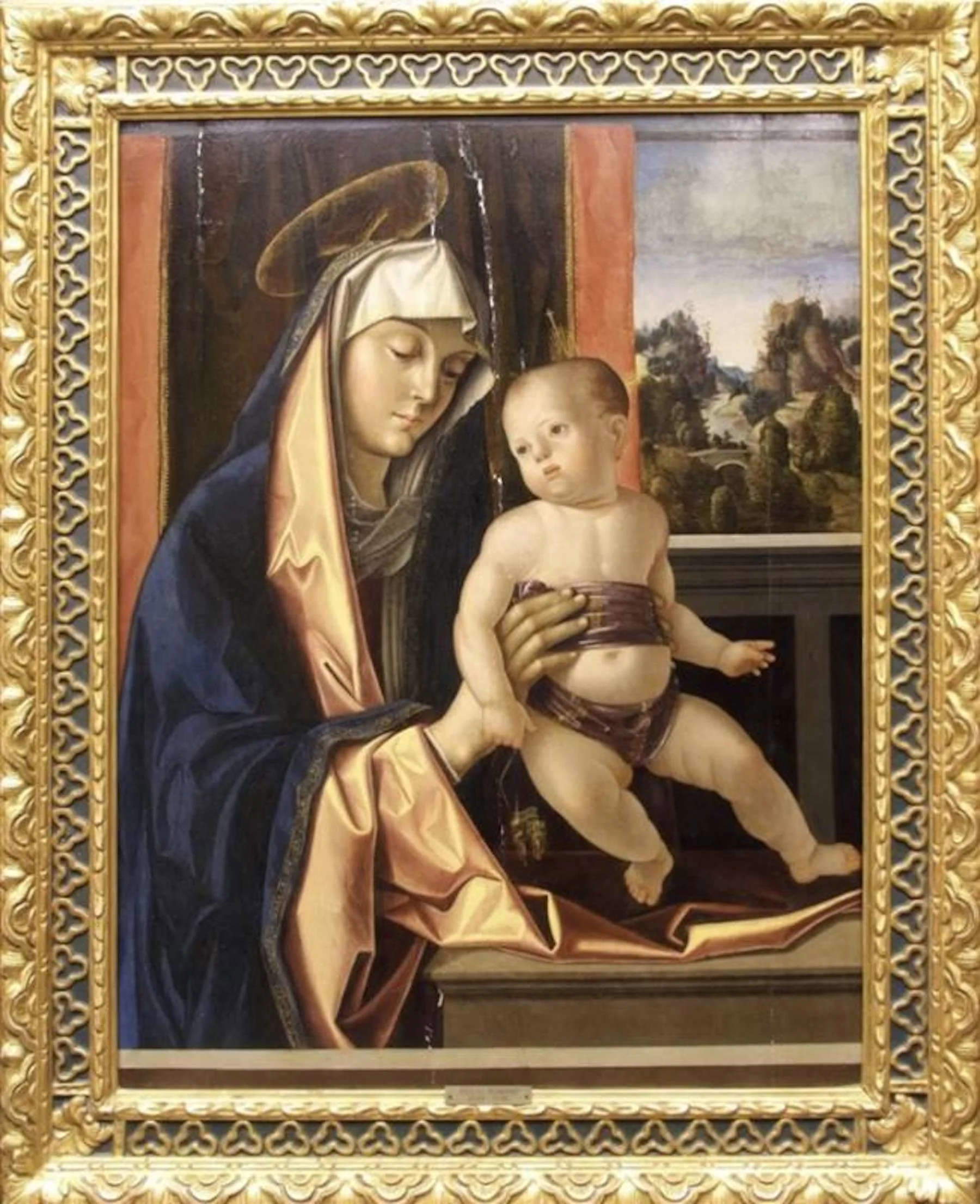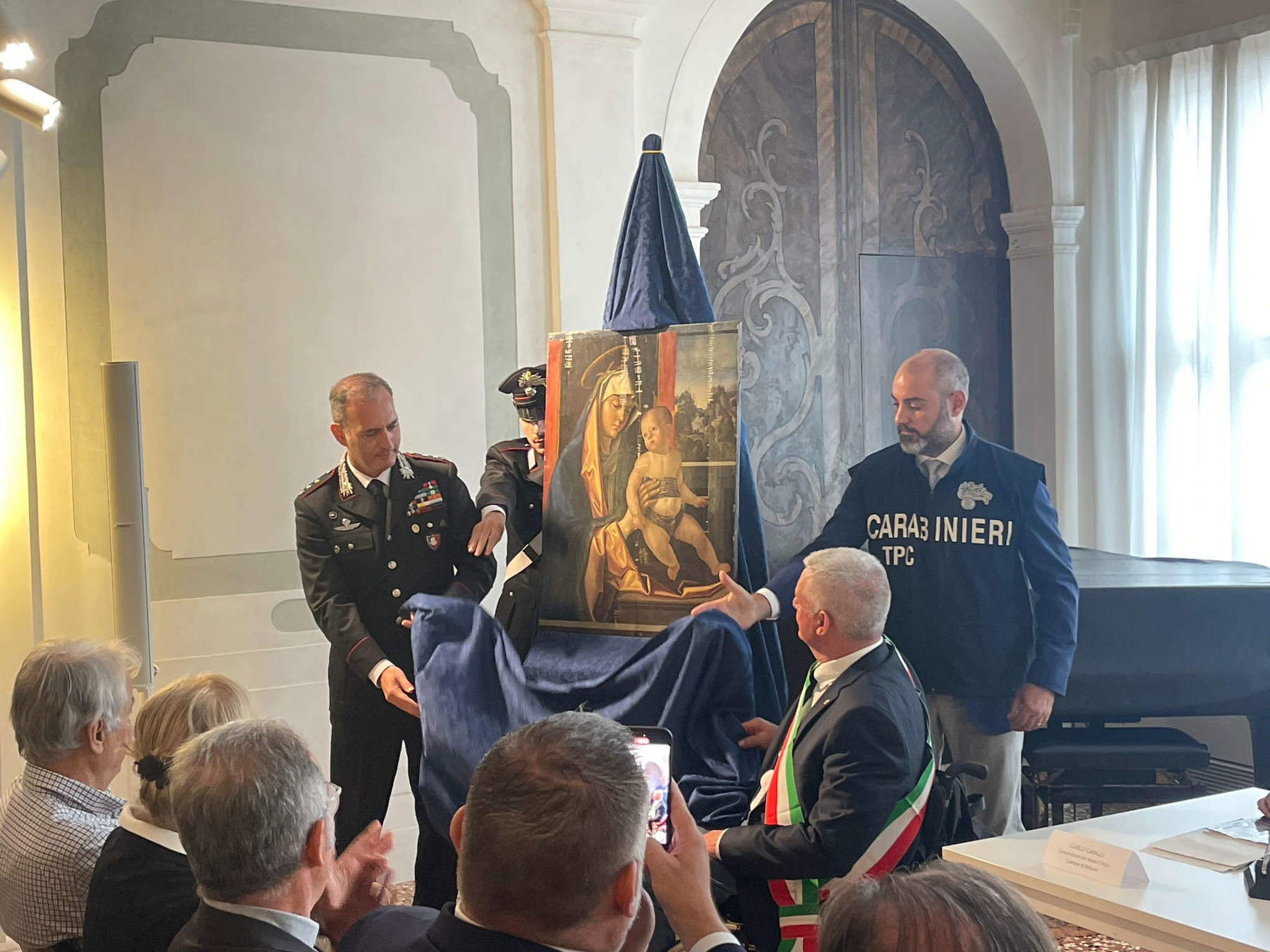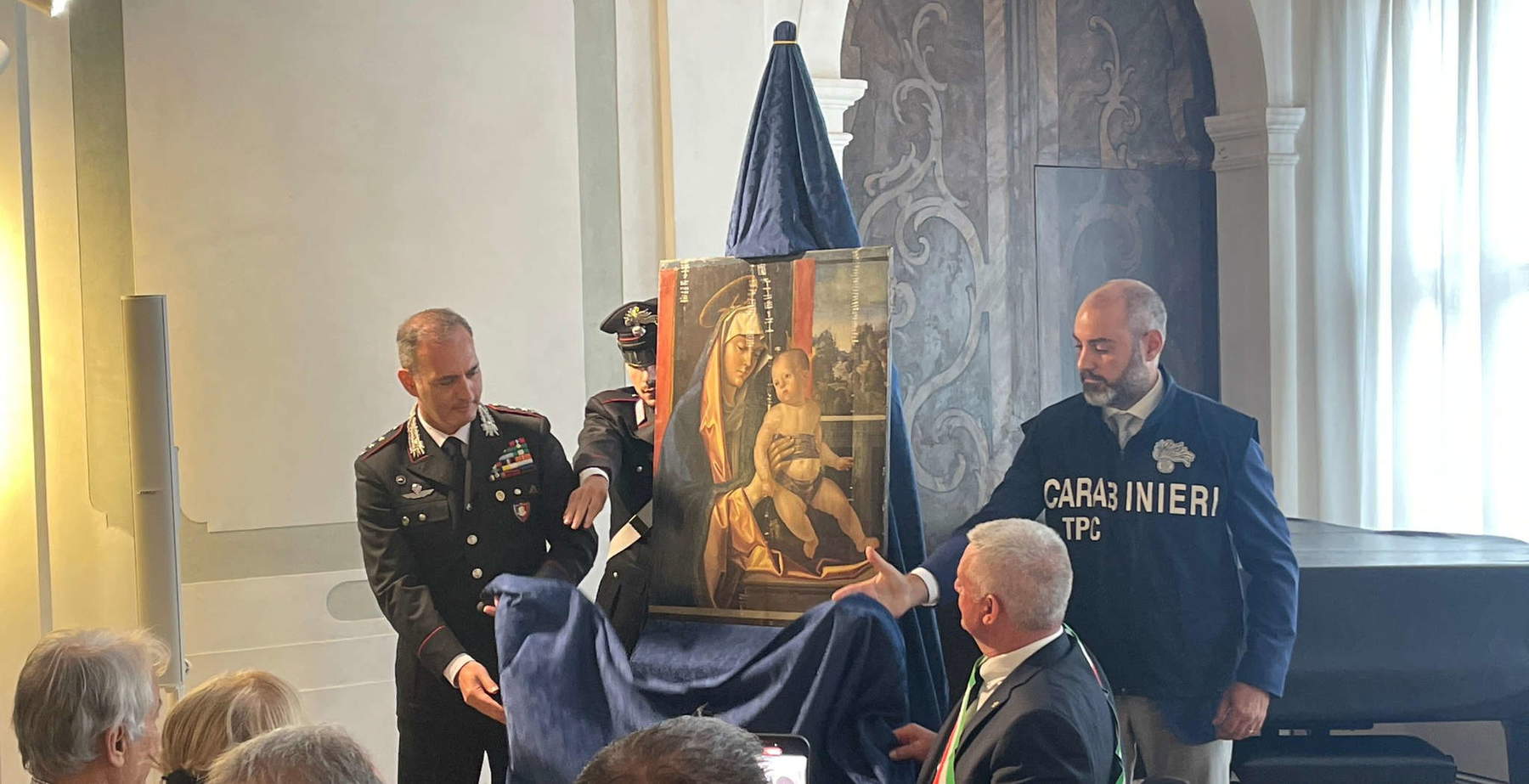More than fifty years after its theft, the Madonna and Child by Antonio Solario (Chieti or Venice, c. 1465 - Naples, 1530), which had been stolen on the night of August 24-25, 1973, from the halls of the museum in the Dolomite capital along with several other works from the civic collection, was returned to the Civic Museums of Belluno. The return was celebrated in the early afternoon of July 21, 2025, at Palazzo Fulcis in Belluno, where a sober but meaningful ceremony was held in the presence of Mayor Oscar De Pellegrin, provincial authorities and the Carabinieri Command for the Protection of Cultural Heritage
The tempera on panel, with dimensions of 86×67 cm, had been acquired by the Belluno museum in 1872, donated by the physician Antonio Giampiccoli, and in the past appeared attributed to Giovanni Bellini, after which the hypothesis was revised and the panel was definitively assigned to Solario with unanimous agreement of the scholars. The work, made in the late 15th and early 16th centuries, evokes the manner of the Venetian school, a refined synthesis of sacred worship and symbolic precision.
Following the 1973 theft, traces of the painting were lost, in contrast to others that were recovered soon after in Austria; it was not until 2017 that the work came to light again in Britain, thanks to an attempted sale in a regional English auction at the Keys Fine Art house in Norwich. The auction house’s report, combined with a check checked against the Carabinieri TPC databases, allowed its identification. From that moment, a long road to recovery began. The Venice Carabinieri TPC Unit, coordinated with the Belluno Public Prosecutor’s Office, the Superintendency for Venice and the Ministry of Culture, launched investigations for illicit export and receiving stolen goods, so the Italian authorities issued rogatory letters and availed themselves of the support of Eurojust, and then obtained the extrajudicial seizure at the Italian embassy in London in May 2025.
The holder of the work turned out to be a British citizen, Barbara de Dozsa, unaware of the painting’s illicit provenance. Following an out-of-court settlement, the work was returned voluntarily, avoiding lengthy court proceedings between British and Italian authorities. However, at first it seemed that things were not to go exactly smoothly, as the Guardian reported. On the British side, in fact, the affair had marked some complex stages.

After it was found and attempted to be sold in 2017, the Norfolk Police seized the painting, but returned it in 2020 to the holder. This happened because of the legal implications related to the Limitations Act of 1980, which could legitimize a possession acquired more than six years earlier as long as the purchase had been in good faith: the owner’s husband, the now-deceased Baron de Dozsa, had in fact purchased the work in good faith in 1973, soon after the theft. It was thanks to the mediation of lawyer Christopher Marinello, founder of Art Recovery International (an organization that deals with stolen works of art) and specializes in art law, that the work was able to return to Italy: in fact, Marinello convinced Barbara de Dosza to return the work, which was only returned to Italy today, eight years after it was found, due to some bureaucratic complications in the exchange of documents between Italy and England.
Initially, the owner was expecting either a refund for the legal fees she faced or an amount equivalent to the canvas’ current value, estimated at around 100,000 euros. Marinello and the Italian authorities finally managed to convince her, and De Dozsa relinquished all rights to the work: the painting, after all, being listed in the Carabinieri’s database of stolen works of art, was neither saleable nor legally transportable, and an out-of-court settlement allowed for its return without litigation. “It restored my faith in humanity when so many owners of stolen artworks today are trying to hold on to them. Despite the victim’s rights, people no longer feel any compassion, and she has proven otherwise,” Marinello told the Guardian. “When it comes to returning stolen artwork and doing the right thing, I can be annoying and pushy. But in the end, it was Barbara de Dozsa’s decision, and she chose wisely.”
The mediation of Arte Generali, the Group’s business unit specializing in the protection of art collections, valuables, home and real estate, which made the recovery possible with a donation that was used to cover the costs of the transfer, also played a decisive role.
The museum’s conservator, Carlo Cavalli, reported that the painting, following the seizure and the years in removal, shows some signs of distress, in particular movements of the wooden support that have caused fractures to the pictorial surface with loss of material. Therefore, it was decided to display it at the museum for only one week, until July 27, before handing it over to restorers.
Other works stolen in 1973, including a second “Madonna and Child” by Placido Fabris, a 19th-century work, still remain out of public ownership, also included in databases of illegally stolen property. Marinello urged the international community to report any sightings related to these paintings.

Belluno Mayor Oscar De Pellegrin said, “The return to Belluno of a masterpiece like Antonio Solario’s represents much more than an institutional success: it is a moral and cultural victory for our entire community. Returning this painting to the City means giving it back a fragment of its identity, its history and its soul. At a time when everything seems to be quick and fleeting, recovering a work stolen over fifty years ago reminds us how important memory, perseverance and a sense of belonging are. I would like to thank with deep gratitude all the institutions that collaborated with dedication and professionalism: the Ministry of Culture, the Carabinieri, the Judicial Authority, ARTE Generali and its distinctive network of professionals, and all the people who, with discretion and commitment, made this result possible. From today, this work of art is not only a found treasure: it is a living symbol of justice, legality and love for the common good. And it will be our care to return it to the citizenry with the respect, value and dignity it deserves.”
Councillor for Culture of the City of Belluno, Raffaele Addamiano, says, “I am truly happy to have contributed to the success of this long and difficult action to recover a fundamental asset for Bellunese, Venetian and Italian Art. Since we took office three years ago, we have been steadfastly and zealously engaged in the complex operation to recover the precious and beautiful 15th-century painting by Antonio Solario, which was stolen back in August 1973 from the old civic museum at the Palazzo dei Giuristi. As often happens at such junctures, teamwork made it possible to achieve the coveted goal of putting, specifically, into practice the provisions of Article 9 of the Republican Constitution regarding the care and protection of the Nation’s historical and artistic heritage. All this for the exclusive benefit of our ancient City, of all its Citizens and, finally, of an authentically free, open and plural cultural offer. There have been difficult times during these long months, and yet, as mountain people always do, we never gave up. Now we can safely say with satisfaction that now Culture in the so-called Shining City has an absolute added value that finally does justice to a remote wrong suffered.”
Italo Carli, Head of ARTE Generali in Italy, said, “This satisfying result highlights the critical role of operational restitution: the meticulous and collaborative work required to track, recover and return works of art not only to their rightful owner but to the entire community. As Generali, our job is to protect: we protect works of art, with ARTE Generali, the Group’s business unit dedicated to art collectors and museum institutions globally through insurance solutions; we protect emotions, with Valore Cultura, Generali’s project in Italy that is committed to supporting art and culture to make them accessible to an ever-widening public.”
Colonel Enrico Pigozzo, Provincial Commander of the Carabinieri in Belluno, said, “This was clearly a complex case, on which there was a delicate interlocutory dynamic between the Italian and British judicial authorities. The delicacy of the case demanded great attention, but above all the need not to demur with respect to its complexity. I would say that the key word of today’s result was precisely ’determination,’ the will of everyone, and certainly of the Arma, to reach today’s result, which is to return a symbol of Belluno to its citizens. And when we realized that we were at the end point, thanks to the indispensable role played by the Comando Carabinieri Tutela Patrimonio Culturale, we further strengthened the coordination between all the actors, until one evening, I received the message that the work was in the Italian Embassy in London, finally on Italian soil, ready to go home.”
 |
| Belluno, Antonio Solario painting stolen in 1973 returned to Civic Museums |
Warning: the translation into English of the original Italian article was created using automatic tools. We undertake to review all articles, but we do not guarantee the total absence of inaccuracies in the translation due to the program. You can find the original by clicking on the ITA button. If you find any mistake,please contact us.